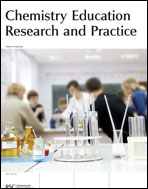Generating cognitive dissonance in student interviews through multiple representations
Abstract
This study explores what students understand about enzyme–substrate interactions, using multiple representations of the phenomenon. In this paper we describe our use of the 3 Phase-Single Interview Technique with multiple representations to generate cognitive dissonance within students in order to uncover misconceptions of enzyme–substrate interactions. Findings from 25 student interviews are interpreted through the lens of multiple theoretical frameworks, including personal constructivism and coherence formation. The importance of classroom teachers engaging students in dialogue about representations is discussed.

 Please wait while we load your content...
Please wait while we load your content...